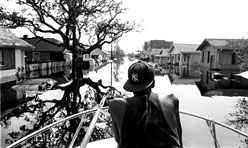|
|
Issue: Disaster Response
|
|
The Katrina Media Fellows uncovered critical problems with the system of disaster response in this country—from system-wide inconsistencies in FEMA flood maps and the resulting effects on homeowners, to major health problems resulting from trailers FEMA issued to displaced Gulf Coast residents. |
|
|
|
|
 |
|
|
Another Black Blues Story |
|
|
Clarence Williams is producing a photographic essay of post-Katrina New Orleans, from flood to aftermath to rebuilding, with a visual emphasis on the remnants of the cultural wealth and family ties that make this city unique. |
|
|  | |
Another Black Blues Story |
| |
|
|
|
|
 |
|
|
New Orleans Now: Weathering the Storm |
|
|
Tena Rubio developed the Katrina Uncovers/New Orleans Now series for the National Radio Project; as part of the project, she produced a 30-minute show on street art, a one-hour show about New Orleans two years after Katrina and a three-part series on the immigrant/migrant workforce in New
Orleans |
|
|  | |
Can Art Help Heal a Broken City? |
| |
|
|
|
|
 |
|
|
Not As Seen On TV |
|
|
Two producers from New York City's Downtown Community Television Center (DCTV) traveled to New Orleans to collaborate with two local teen reporters on videos that illustrate how people of all ages are coping after Katrina. The films touch on how art can be used for healing, how residents are helping themselves in the absence of government support, and how issues of race, culture, and poverty continue to play a central role in recovery, relief, and revitalization efforts. |
|
|  | |
Not As Seen On TV |
| |
|
|
|
|
 |
|
|
Those Who Fell Through the Cracks |
|
|
"Those Who Fell Through the Cracks" is a collaborative photography project by Stanley Greene and Kadir van Lohuizen that documents Hurricane Katrina's effects on Gulf Coast residents who are still struggling to reestablish their lives after the storm. |
|
|  | |
Photographs by Stanley Greene |
| |
|
|
|
|
 |
|
|
Toxic Trailers |
|
|
Amanda Spake researched and reported on the long-term impact of Katrina on the health of Gulf Coast residents; special focus was given to residents who had moved into FEMA-supplied trailers, which are now creating a major health care crisis of their own. |
|
|  | |
Dying for a Home |
| |  | |
The Formaldehyde Cover-Up |
| |
|
|
|
|
 |
|
|
Won't Bow Down |
|
|
Larry Blumenfeld researched and wrote about the post-Katrina realities faced by the prime movers in New Orleans's musical subcultures—from jazz musicians and brass band players to tribes of Mardi Gras Indians and the Social Aid and Pleasure clubs—and the cultural crises that emerged in the wake of the 2005 floods. |
|
|  | |
Magic and Loss |
| |  | |
Mending the Levees |
| |  | |
Not Wash Away |
| |
|
|
|
|
|